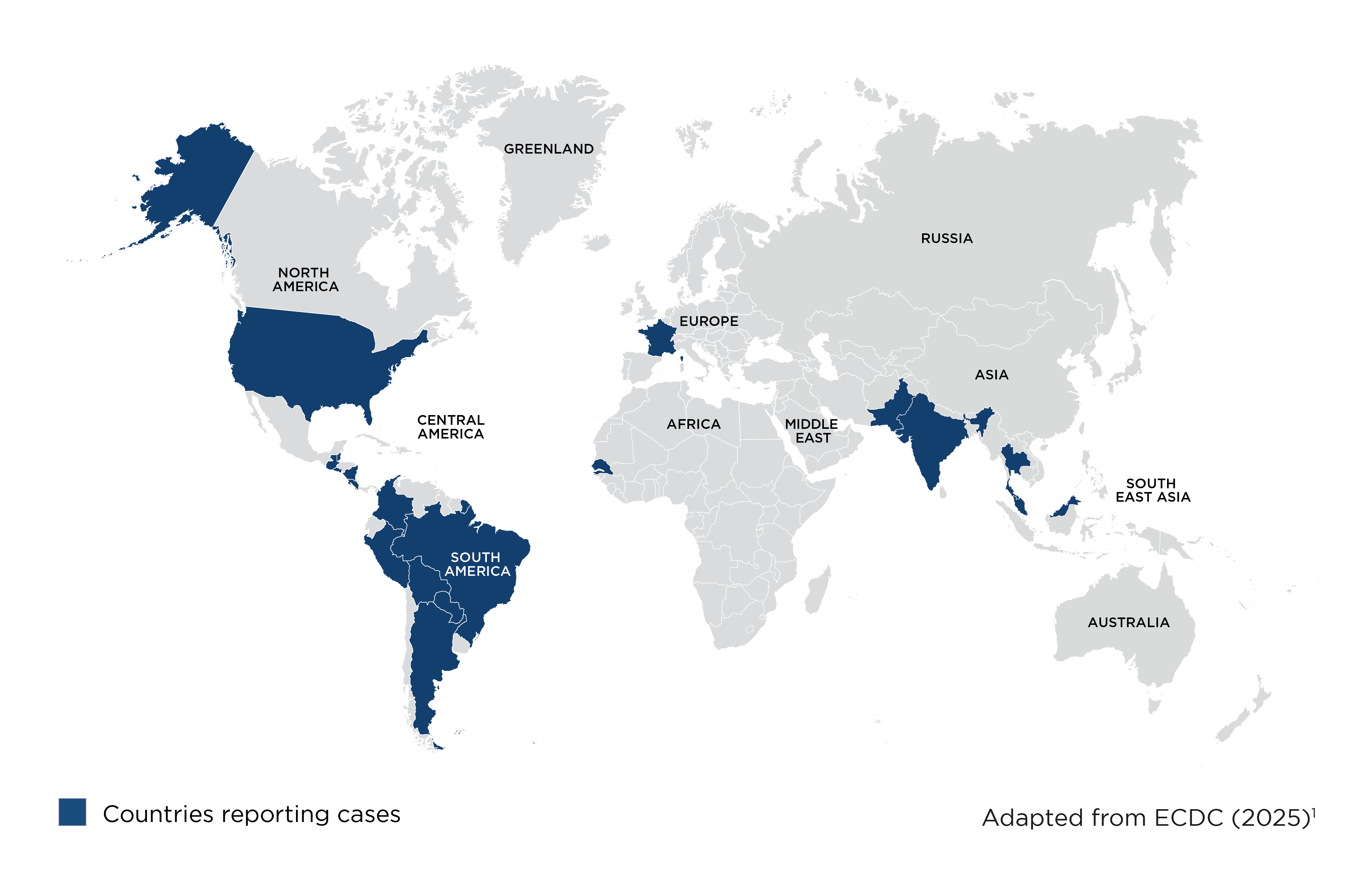In Kimakonde, a language spoken in Tanzania and Mozambique, ‘Chikungunya’ means ‘to become contorted’ (bent out of normal shape), which may result from severe joint pain.2
Risk areas for Chikungunya

FAQs
-
Key fact
-
How do you get chikungunya?
When you’re bitten by mosquitoes carrying the virus. These mosquitoes may also be carrying other viruses, such as dengue fever.2
-
Which countries are affected by chikungunya?
Cases and outbreaks have been reported in over a hundred countries in the Americas, Africa, Asia, Europe, and the Indian and Pacific Oceans.1,3
-
What are the symptoms of chikungunya?
In those without significant joint pain, symptoms are usually mild and the infection may not be obvious.2
If symptoms do occur, this is usually between 4 and 8 days after being bitten but can be between 2 and 12 days, therefore you may start to feel ill when you are back home after your trip.2 These can include sudden onset of fever, pain in the joints and muscles, headache, nausea, fatigue and rash. The joint pain can be debilitating.2
-
How serious is chikungunya?
Serious cases are not common and most people make a full recovery. However, pain in the joints can last for months or even years, and while symptoms can be treated, there is no known cure for the infection.2
-
Can I prevent getting chikungunya?
You can take the following precautions to help reduce your risk of infection:
- Visit your nearest convenient pharmacy or specialist travel health clinic for a risk assessment before your trip
- Use a recommended insect repellent containing either Picaridin, DEET, PMD or OLE (oil of lemon eucalyptus), IR3535 or 2-undecanone4
- Wear appropriate clothing (e.g., loose fitting long-sleeved clothes, long trousers, socks and shoes) to minimise exposed skin5,6
- Use insecticide-treated mosquito nets if you are sleeping or resting in accommodation that is not air-conditioned or sleeping outdoors during the day or night5
Ready to get started? Check now for your nearest travel health clinic.
Get friendly advice from the UK's largest network of travel clinics*.
* This list is not exhaustive and other travel health providers are available.
References
- European Centre for Disease Prevention and Control. Twelve-month Chikungunya virus disease case notification rate per 100 000 population, April 2024-March 2025. April 2025. Available at: https://www.ecdc.europa.eu/en/publications-data/twelve-month-chikungunya-virus-disease-case-notification-rate-100-000-0. (Last accessed May 2025)
- World Health Organization. Fact sheets. Chikungunya. April 2025. Available online: https://www.who.int/news-room/fact-sheets/detail/chikungunya (Last accessed May 2025)
- Centers for Disease Control and Prevention. Chikungunya Virus. Areas at Risk for Chikungunya. May 2025. Available online: https://www.cdc.gov/chikungunya/data-maps/?CDC_AAref_Val=https://www.cdc.gov/chikungunya/geo/. (Last accessed May 2025)
- Centers for Disease Control and Prevention. Yellow Book 2026. Environmental Hazards & Risks. Mosquitoes, Ticks & Other Arthropods. April 2025. Available online: https://www.cdc.gov/yellow-book/hcp/environmental-hazards-risks/mosquitoes-ticks-and-other-arthropods.html (Last accessed May 2025)
- UK Health Security Agency. Mosquito bite avoidance for travellers. January 2023. Available online: https://www.gov.uk/government/publications/mosquito-bite-avoidance-for-travellers (Last accessed May 2025)
- Fit for Travel. General Travel Health Advice. Mosquito Bite Avoidance: advice for travellers. Available online: https://www.fitfortravel.nhs.uk/advice/malaria/mosquito-bite-avoidance (Last accessed May 2025)
UK-BOTB-2500019 May 2025
